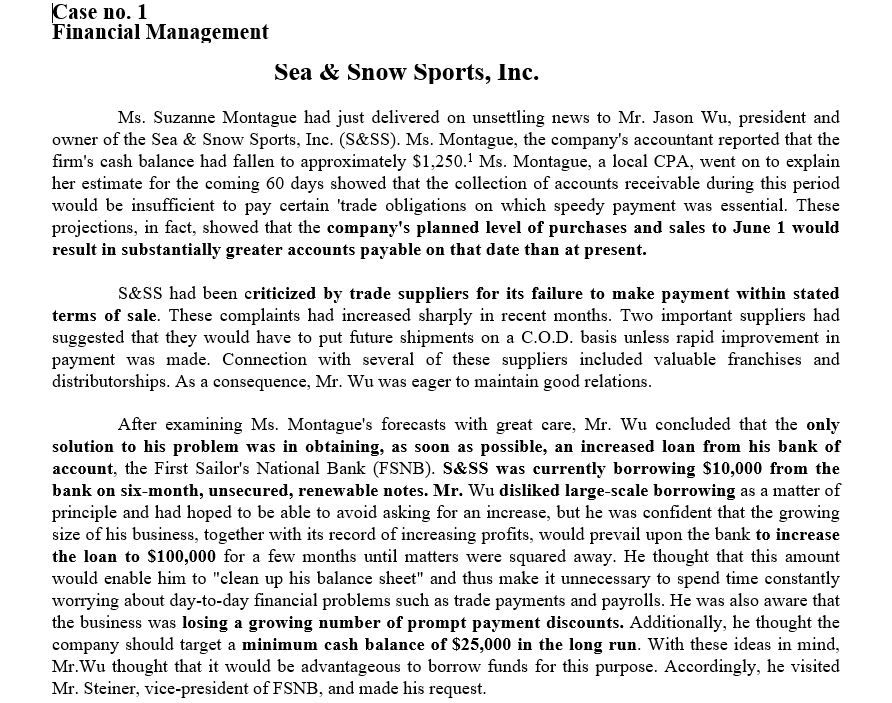
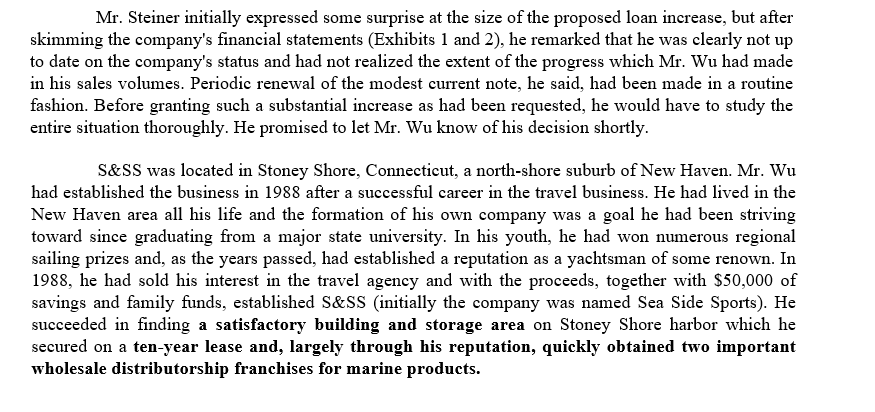
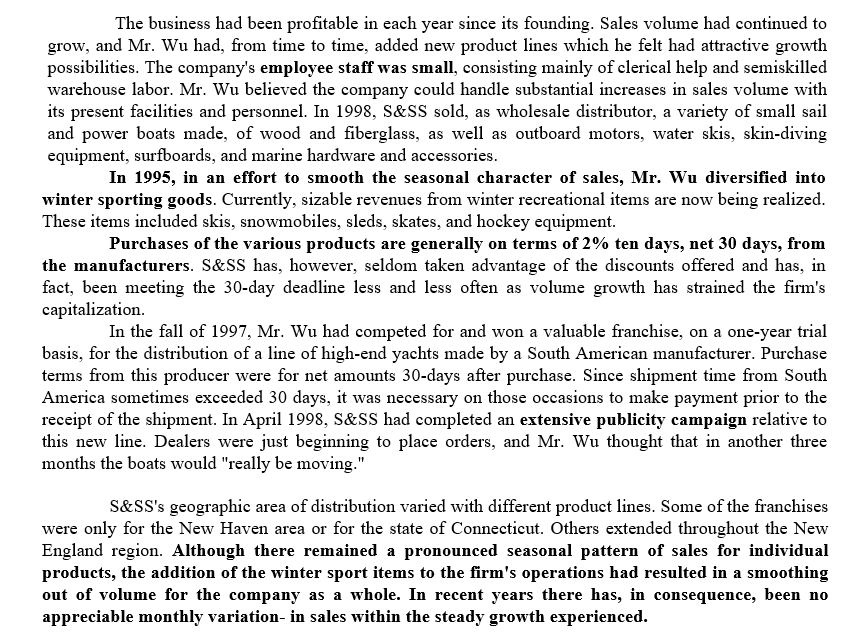
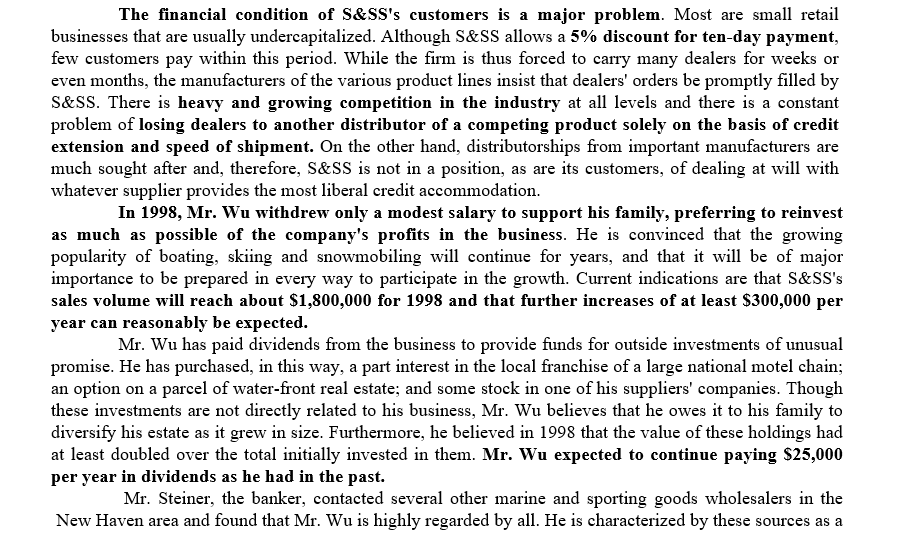
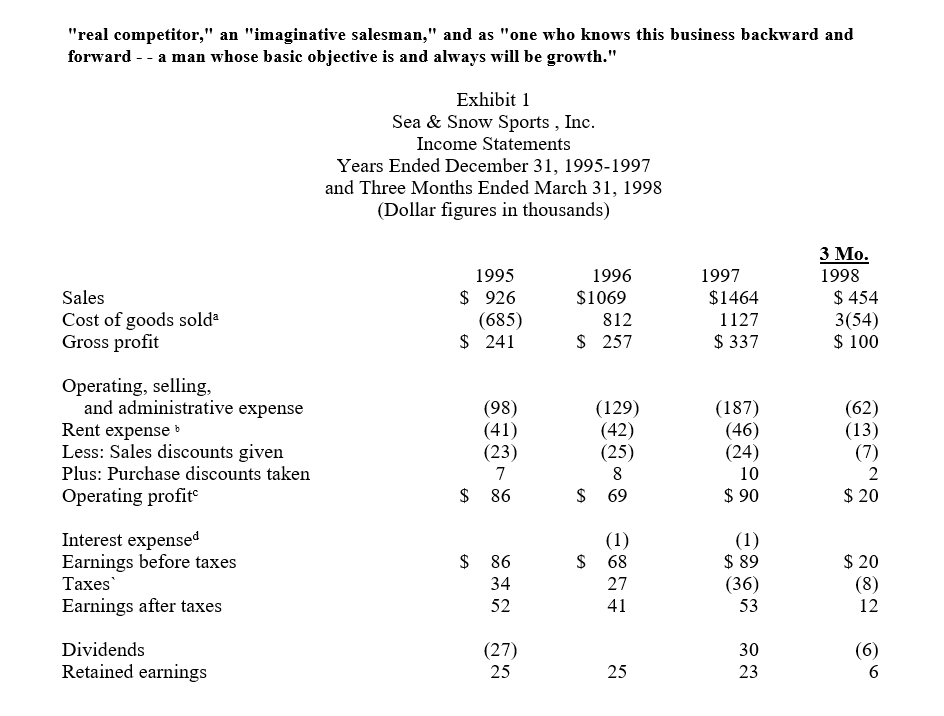
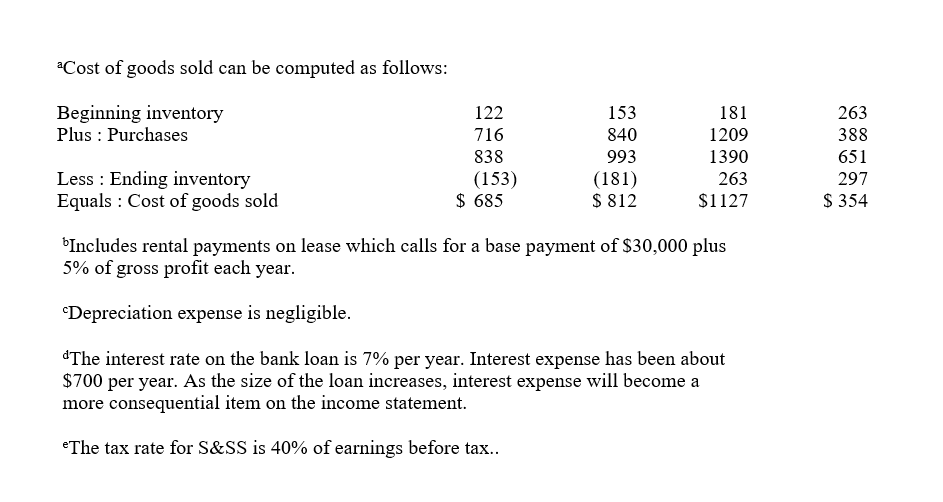
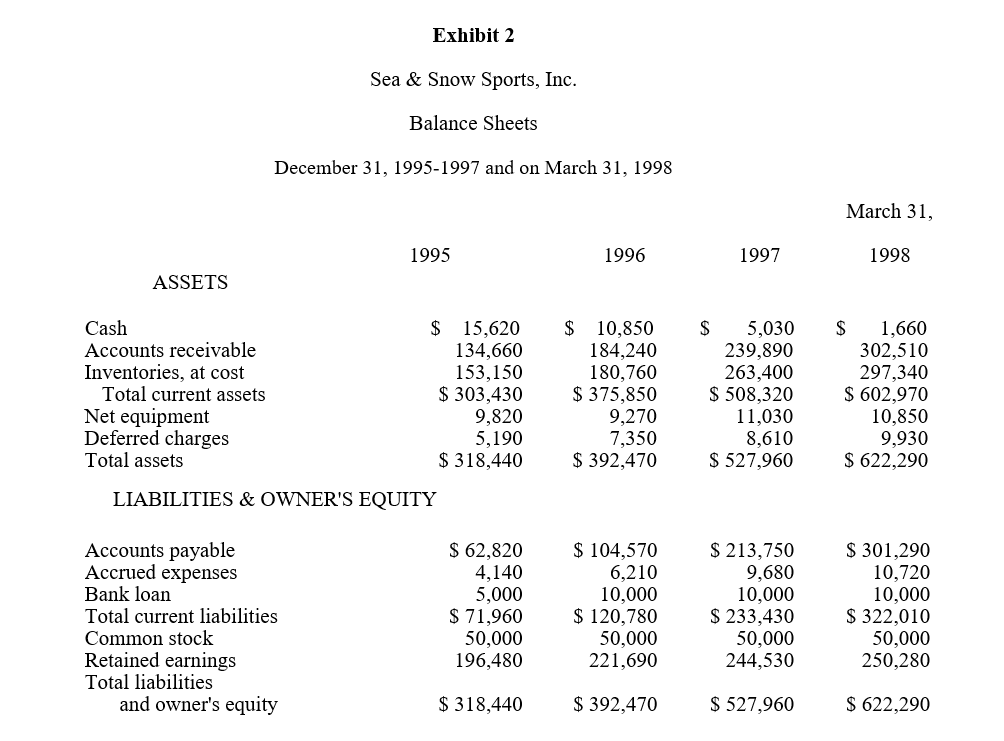
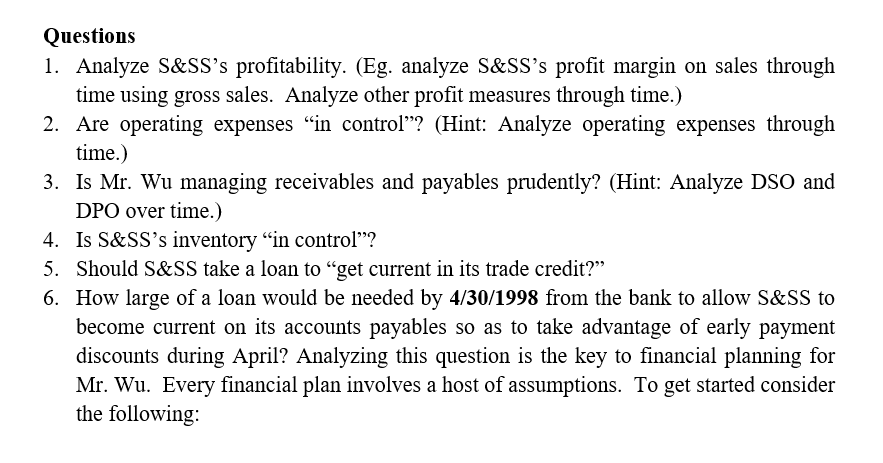
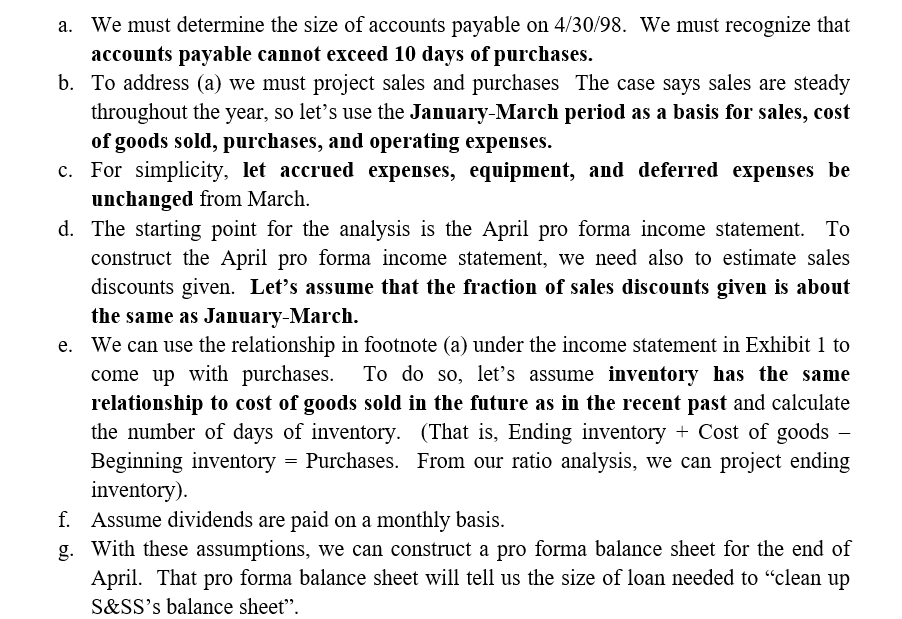

Case no. 1 Financial Management Sea & Snow Sports, Inc. Ms. Suzanne Montague had just delivered on unsettling news to Mr. Jason Wu, president and owner of the Sea & Snow Sports, Inc. (S&SS). Ms. Montague, the company's accountant reported that the firm's cash balance had fallen to approximately $1,250.1 Ms. Montague, a local CPA, went on to explain her estimate for the coming 60 days showed that the collection of accounts receivable during this period would be insufficient to pay certain 'trade obligations on which speedy payment was essential. These projections, in fact, showed that the company's planned level of purchases and sales to June 1 would result in substantially greater accounts payable on that date than at present. S&SS had been criticized by trade suppliers for its failure to make payment within stated terms of sale. These complaints had increased sharply in recent months. Two important suppliers had suggested that they would have to put future shipments on a C.O.D. basis unless rapid improvement in payment was made. Connection with several of these suppliers included valuable franchises and distributorships. As a consequence, Mr. Wu was eager to maintain good relations. After examining Ms. Montague's forecasts with great care, Mr. Wu concluded that the only solution to his problem was in obtaining, as soon as possible, an increased loan from his bank of account, the First Sailor's National Bank (FSNB). S&SS was currently borrowing $10,000 from the bank on six-month, unsecured, renewable notes. Mr. Wu disliked large-scale borrowing as a matter of principle and had hoped to be able to avoid asking for an increase, but he was confident that the growing size of his business, together with its record of increasing profits, would prevail upon the bank to increase the loan to $100,000 for a few months until matters were squared away. He thought that this amount would enable him to "clean up his balance sheet" and thus make it unnecessary to spend time constantly worrying about day-to-day financial problems such as trade payments and payrolls. He was also aware that the business was losing a growing number of prompt payment discounts. Additionally, he thought the company should target a minimum cash balance of $25,000 in the long run. With these ideas in mind, Mr. Wu thought that it would be advantageous to borrow funds for this purpose. Accordingly, he visited Mr. Steiner, vice-president of FSNB, and made his request. The business had been profitable in each year since its founding. Sales volume had continued to grow, and Mr. Wu had, from time to time, added new product lines which he felt had attractive growth possibilities. The company's employee staff was small, consisting mainly of clerical help and semiskilled warehouse labor. Mr. Wu believed the company could handle substantial increases in sales volume with its present facilities and personnel. In 1998, S&SS sold, as wholesale distributor, a variety of small sail and power boats made, of wood and fiberglass, as well as outboard motors, water skis, skin-diving equipment, surfboards, and marine hardware and accessories. In 1995, in an effort to smooth the seasonal character of sales, Mr. Wu diversified into winter sporting goods. Currently, sizable revenues from winter recreational items are now being realized. These items included skis, snowmobiles, sleds, skates, and hockey equipment. Purchases of the various products are generally on terms of 2% ten days, net 30 days, from the manufacturers. S&SS has, however, seldom taken advantage of the discounts offered and has, in fact, been meeting the 30-day deadline less and less often as volume growth has strained the firm's capitalization. In the fall of 1997, Mr. Wu had competed for and won a valuable franchise, on a one-year trial basis, for the distribution of a line of high-end yachts made by a South American manufacturer. Purchase terms from this producer were for net amounts 30-days after purchase. Since shipment time from South America sometimes exceeded 30 days, it was necessary on those occasions to make payment prior to the receipt of the shipment. In April 1998, S&SS had completed an extensive publicity campaign relative to this new line. Dealers were just beginning to place orders, and Mr. Wu thought that in another three months the boats would "really be moving." S&SS's geographic area of distribution varied with different product lines. Some of the franchises were only for the New Haven area or for the state of Connecticut. Others extended throughout the New England region. Although there remained a pronounced seasonal pattern of sales for individual products, the addition of the winter sport items to the firm's operations had resulted in a smoothing out of volume for the company as a whole. In recent years there has, in consequence, been no appreciable monthly variation- in sales within the steady growth experienced. The financial condition of S&SS's customers is a major problem. Most are small retail businesses that are usually undercapitalized. Although S&SS allows a 5% discount for ten-day payment, few customers pay within this period. While the firm is thus forced to carry many dealers for weeks or even months, the manufacturers of the various product lines insist that dealers' orders be promptly filled by S&SS. There is heavy and growing competition in the industry at all levels and there is a constant problem of losing dealers to another distributor of a competing product solely on the basis of credit extension and speed of shipment. On the other hand, distributorships from important manufacturers are much sought after and, therefore, S&SS is not in a position, as are its customers, of dealing at will with whatever supplier provides the most liberal credit accommodation. In 1998, Mr. Wu withdrew only a modest salary to support his family, preferring to reinvest as much as possible of the company's profits in the business. He is convinced that the growing popularity of boating, skiing and snowmobiling will continue for years, and that it will be of major importance to be prepared in every way to participate in the growth. Current indications are that S&SS's sales volume will reach about $1,800,000 for 1998 and that further increases of at least $300,000 per year can reasonably be expected. Mr. Wu has paid dividends from the business to provide funds for outside investments of unusual promise. He has purchased, in this way, a part interest in the local franchise of a large national motel chain; an option on a parcel of water-front real estate; and some stock in one of his suppliers' companies. Though these investments are not directly related to his business, Mr. Wu believes that he owes it to his family to diversify his estate as it grew in size. Furthermore, he believed in 1998 that the value of these holdings had at least doubled over the total initially invested in them. Mr. Wu expected to continue paying $25,000 per year in dividends as he had in the past. Mr. Steiner, the banker, contacted several other marine and sporting goods wholesalers in the New Haven area and found that Mr. Wu is highly regarded by all. He is characterized by these sources as a "real competitor," an "imaginative salesman," and as "one who knows this business backward and forward -- a man whose basic objective is and always will be growth." Exhibit 1 Sea & Snow Sports, Inc. Income Statements Years Ended December 31, 1995-1997 and Three Months Ended March 31, 1998 (Dollar figures in thousands) Sales Cost of goods solda Gross profit 1995 $ 926 (685) $ 241 1996 $1069 812 $ 257 1997 $1464 1127 $ 337 3 Mo. 1998 $ 454 3(54) $ 100 Operating, selling, and administrative expense Rent expense Less: Sales discounts given Plus: Purchase discounts taken Operating profit (98) (41) (23) 7 $ 86 (129) (42) (25) 8 $ 69 (187) (46) (24) 10 $ 90 (62) (13) (7) 2 $ 20 $ Interest expensed Earnings before taxes Taxes Earnings after taxes $ 86 34 52 (1) 68 27 41 (1) $ 89 (36) 53 $ 20 (8) 12 Dividends Retained earnings (27) 25 30 23 (6) 6 25 *Cost of goods sold can be computed as follows: Beginning inventory Plus: Purchases 122 716 838 (153) $ 685 153 840 993 (181) $ 812 181 1209 1390 263 $1127 263 388 651 297 $ 354 Less : Ending inventory Equals : Cost of goods sold Includes rental payments on lease which calls for a base payment of $30,000 plus 5% of gross profit each year. Depreciation expense is negligible. dThe interest rate on the bank loan is 7% per year. Interest expense has been about $700 per year. As the size of the loan increases, interest expense will become a more consequential item on the income statement. The tax rate for S&SS is 40% of earnings before tax.. Exhibit 2 Sea & Snow Sports, Inc. Balance Sheets December 31, 1995-1997 and on March 31, 1998 March 31, 1995 1996 1997 1998 ASSETS Cash Accounts receivable Inventories, at cost Total current assets Net equipment Deferred charges Total assets $ 15,620 134,660 153,150 $ 303,430 9,820 5,190 $ 318,440 $ 10,850 184,240 180,760 $ 375,850 9,270 7,350 $ 392,470 $ 5,030 239,890 263,400 $ 508,320 11,030 8,610 $ 527,960 $ 1,660 302,510 297,340 $ 602,970 10,850 9,930 $ 622,290 LIABILITIES & OWNER'S EQUITY Accounts payable Accrued expenses Bank loan Total current liabilities Common stock Retained earnings Total liabilities and owner's equity $ 62,820 4,140 5,000 $ 71,960 50,000 196,480 $ 104,570 6,210 10,000 $ 120,780 50,000 221,690 $ 213,750 9,680 10,000 $ 233,430 50,000 244,530 $ 301,290 10,720 10,000 $ 322,010 50,000 250,280 $ 318,440 $ 392,470 $ 527,960 $ 622,290 Questions 1. Analyze S&SS's profitability. (Eg. analyze S&SS's profit margin on sales through time using gross sales. Analyze other profit measures through time.) 2. Are operating expenses in control? (Hint: Analyze operating expenses through time.) 3. Is Mr. Wu managing receivables and payables prudently? (Hint: Analyze DSO and DPO over time.) 4. Is S&SS's inventory in control? 5. Should S&SS take a loan to get current in its trade credit? 6. How large of a loan would be needed by 4/30/1998 from the bank to allow S&SS to become current on its accounts payables so as to take advantage of early payment discounts during April? Analyzing this question is the key to financial planning for Mr. Wu. Every financial plan involves a host of assumptions. To get started consider the following: a. We must determine the size of accounts payable on 4/30/98. We must recognize that accounts payable cannot exceed 10 days of purchases. b. To address (a) we must project sales and purchases The case says sales are steady throughout the year, so let's use the January-March period as a basis for sales, cost of goods sold, purchases, and operating expenses. c. For simplicity, let accrued expenses, equipment, and deferred expenses be unchanged from March. d. The starting point for the analysis is the April pro forma income statement. To construct the April pro forma income statement, we need also to estimate sales discounts given. Let's assume that the fraction of sales discounts given is about the same as January-March. e. We can use the relationship in footnote (a) under the income statement in Exhibit 1 to come up with purchases. To do so, let's assume inventory has the same relationship to cost of goods sold in the future as in the recent past and calculate the number of days of inventory. (That is, Ending inventory + Cost of goods Beginning inventory = Purchases. From our ratio analysis, we can project ending inventory). f. Assume dividends are paid on a monthly basis. g. With these assumptions, we can construct a pro forma balance sheet for the end of April. That pro forma balance sheet will tell us the size of loan needed to clean up S&SS's balance sheet". 7. Construct a long-term financial plan. Specifically, produce pro forma income statements for the full year 1998, 1999, and 2000 and year-end balance sheets for 1998, 1999 and 2000. (We will need to make additional assumptions to construct these pro formas. The assumptions from #6 above will serve as the starting point and let's accept Mr. Wu's sales projections. We also must recognize that most items will grow with sales including cost of goods sold and operating expenses. To calculate receivables and inventory, let's use historical DSO (or ACP) and historical Days of Inventory. But, for simplicity, let equipment, deferred charges and accrued expenses remain constant) 8. Calculate the g* and the actual g for the historical period and the projected period and conclude whether the company has made a correct decision on financing its needs and properly managed internal resources. Case no. 1 Financial Management Sea & Snow Sports, Inc. Ms. Suzanne Montague had just delivered on unsettling news to Mr. Jason Wu, president and owner of the Sea & Snow Sports, Inc. (S&SS). Ms. Montague, the company's accountant reported that the firm's cash balance had fallen to approximately $1,250.1 Ms. Montague, a local CPA, went on to explain her estimate for the coming 60 days showed that the collection of accounts receivable during this period would be insufficient to pay certain 'trade obligations on which speedy payment was essential. These projections, in fact, showed that the company's planned level of purchases and sales to June 1 would result in substantially greater accounts payable on that date than at present. S&SS had been criticized by trade suppliers for its failure to make payment within stated terms of sale. These complaints had increased sharply in recent months. Two important suppliers had suggested that they would have to put future shipments on a C.O.D. basis unless rapid improvement in payment was made. Connection with several of these suppliers included valuable franchises and distributorships. As a consequence, Mr. Wu was eager to maintain good relations. After examining Ms. Montague's forecasts with great care, Mr. Wu concluded that the only solution to his problem was in obtaining, as soon as possible, an increased loan from his bank of account, the First Sailor's National Bank (FSNB). S&SS was currently borrowing $10,000 from the bank on six-month, unsecured, renewable notes. Mr. Wu disliked large-scale borrowing as a matter of principle and had hoped to be able to avoid asking for an increase, but he was confident that the growing size of his business, together with its record of increasing profits, would prevail upon the bank to increase the loan to $100,000 for a few months until matters were squared away. He thought that this amount would enable him to "clean up his balance sheet" and thus make it unnecessary to spend time constantly worrying about day-to-day financial problems such as trade payments and payrolls. He was also aware that the business was losing a growing number of prompt payment discounts. Additionally, he thought the company should target a minimum cash balance of $25,000 in the long run. With these ideas in mind, Mr. Wu thought that it would be advantageous to borrow funds for this purpose. Accordingly, he visited Mr. Steiner, vice-president of FSNB, and made his request. The business had been profitable in each year since its founding. Sales volume had continued to grow, and Mr. Wu had, from time to time, added new product lines which he felt had attractive growth possibilities. The company's employee staff was small, consisting mainly of clerical help and semiskilled warehouse labor. Mr. Wu believed the company could handle substantial increases in sales volume with its present facilities and personnel. In 1998, S&SS sold, as wholesale distributor, a variety of small sail and power boats made, of wood and fiberglass, as well as outboard motors, water skis, skin-diving equipment, surfboards, and marine hardware and accessories. In 1995, in an effort to smooth the seasonal character of sales, Mr. Wu diversified into winter sporting goods. Currently, sizable revenues from winter recreational items are now being realized. These items included skis, snowmobiles, sleds, skates, and hockey equipment. Purchases of the various products are generally on terms of 2% ten days, net 30 days, from the manufacturers. S&SS has, however, seldom taken advantage of the discounts offered and has, in fact, been meeting the 30-day deadline less and less often as volume growth has strained the firm's capitalization. In the fall of 1997, Mr. Wu had competed for and won a valuable franchise, on a one-year trial basis, for the distribution of a line of high-end yachts made by a South American manufacturer. Purchase terms from this producer were for net amounts 30-days after purchase. Since shipment time from South America sometimes exceeded 30 days, it was necessary on those occasions to make payment prior to the receipt of the shipment. In April 1998, S&SS had completed an extensive publicity campaign relative to this new line. Dealers were just beginning to place orders, and Mr. Wu thought that in another three months the boats would "really be moving." S&SS's geographic area of distribution varied with different product lines. Some of the franchises were only for the New Haven area or for the state of Connecticut. Others extended throughout the New England region. Although there remained a pronounced seasonal pattern of sales for individual products, the addition of the winter sport items to the firm's operations had resulted in a smoothing out of volume for the company as a whole. In recent years there has, in consequence, been no appreciable monthly variation- in sales within the steady growth experienced. The financial condition of S&SS's customers is a major problem. Most are small retail businesses that are usually undercapitalized. Although S&SS allows a 5% discount for ten-day payment, few customers pay within this period. While the firm is thus forced to carry many dealers for weeks or even months, the manufacturers of the various product lines insist that dealers' orders be promptly filled by S&SS. There is heavy and growing competition in the industry at all levels and there is a constant problem of losing dealers to another distributor of a competing product solely on the basis of credit extension and speed of shipment. On the other hand, distributorships from important manufacturers are much sought after and, therefore, S&SS is not in a position, as are its customers, of dealing at will with whatever supplier provides the most liberal credit accommodation. In 1998, Mr. Wu withdrew only a modest salary to support his family, preferring to reinvest as much as possible of the company's profits in the business. He is convinced that the growing popularity of boating, skiing and snowmobiling will continue for years, and that it will be of major importance to be prepared in every way to participate in the growth. Current indications are that S&SS's sales volume will reach about $1,800,000 for 1998 and that further increases of at least $300,000 per year can reasonably be expected. Mr. Wu has paid dividends from the business to provide funds for outside investments of unusual promise. He has purchased, in this way, a part interest in the local franchise of a large national motel chain; an option on a parcel of water-front real estate; and some stock in one of his suppliers' companies. Though these investments are not directly related to his business, Mr. Wu believes that he owes it to his family to diversify his estate as it grew in size. Furthermore, he believed in 1998 that the value of these holdings had at least doubled over the total initially invested in them. Mr. Wu expected to continue paying $25,000 per year in dividends as he had in the past. Mr. Steiner, the banker, contacted several other marine and sporting goods wholesalers in the New Haven area and found that Mr. Wu is highly regarded by all. He is characterized by these sources as a "real competitor," an "imaginative salesman," and as "one who knows this business backward and forward -- a man whose basic objective is and always will be growth." Exhibit 1 Sea & Snow Sports, Inc. Income Statements Years Ended December 31, 1995-1997 and Three Months Ended March 31, 1998 (Dollar figures in thousands) Sales Cost of goods solda Gross profit 1995 $ 926 (685) $ 241 1996 $1069 812 $ 257 1997 $1464 1127 $ 337 3 Mo. 1998 $ 454 3(54) $ 100 Operating, selling, and administrative expense Rent expense Less: Sales discounts given Plus: Purchase discounts taken Operating profit (98) (41) (23) 7 $ 86 (129) (42) (25) 8 $ 69 (187) (46) (24) 10 $ 90 (62) (13) (7) 2 $ 20 $ Interest expensed Earnings before taxes Taxes Earnings after taxes $ 86 34 52 (1) 68 27 41 (1) $ 89 (36) 53 $ 20 (8) 12 Dividends Retained earnings (27) 25 30 23 (6) 6 25 *Cost of goods sold can be computed as follows: Beginning inventory Plus: Purchases 122 716 838 (153) $ 685 153 840 993 (181) $ 812 181 1209 1390 263 $1127 263 388 651 297 $ 354 Less : Ending inventory Equals : Cost of goods sold Includes rental payments on lease which calls for a base payment of $30,000 plus 5% of gross profit each year. Depreciation expense is negligible. dThe interest rate on the bank loan is 7% per year. Interest expense has been about $700 per year. As the size of the loan increases, interest expense will become a more consequential item on the income statement. The tax rate for S&SS is 40% of earnings before tax.. Exhibit 2 Sea & Snow Sports, Inc. Balance Sheets December 31, 1995-1997 and on March 31, 1998 March 31, 1995 1996 1997 1998 ASSETS Cash Accounts receivable Inventories, at cost Total current assets Net equipment Deferred charges Total assets $ 15,620 134,660 153,150 $ 303,430 9,820 5,190 $ 318,440 $ 10,850 184,240 180,760 $ 375,850 9,270 7,350 $ 392,470 $ 5,030 239,890 263,400 $ 508,320 11,030 8,610 $ 527,960 $ 1,660 302,510 297,340 $ 602,970 10,850 9,930 $ 622,290 LIABILITIES & OWNER'S EQUITY Accounts payable Accrued expenses Bank loan Total current liabilities Common stock Retained earnings Total liabilities and owner's equity $ 62,820 4,140 5,000 $ 71,960 50,000 196,480 $ 104,570 6,210 10,000 $ 120,780 50,000 221,690 $ 213,750 9,680 10,000 $ 233,430 50,000 244,530 $ 301,290 10,720 10,000 $ 322,010 50,000 250,280 $ 318,440 $ 392,470 $ 527,960 $ 622,290 Questions 1. Analyze S&SS's profitability. (Eg. analyze S&SS's profit margin on sales through time using gross sales. Analyze other profit measures through time.) 2. Are operating expenses in control? (Hint: Analyze operating expenses through time.) 3. Is Mr. Wu managing receivables and payables prudently? (Hint: Analyze DSO and DPO over time.) 4. Is S&SS's inventory in control? 5. Should S&SS take a loan to get current in its trade credit? 6. How large of a loan would be needed by 4/30/1998 from the bank to allow S&SS to become current on its accounts payables so as to take advantage of early payment discounts during April? Analyzing this question is the key to financial planning for Mr. Wu. Every financial plan involves a host of assumptions. To get started consider the following: a. We must determine the size of accounts payable on 4/30/98. We must recognize that accounts payable cannot exceed 10 days of purchases. b. To address (a) we must project sales and purchases The case says sales are steady throughout the year, so let's use the January-March period as a basis for sales, cost of goods sold, purchases, and operating expenses. c. For simplicity, let accrued expenses, equipment, and deferred expenses be unchanged from March. d. The starting point for the analysis is the April pro forma income statement. To construct the April pro forma income statement, we need also to estimate sales discounts given. Let's assume that the fraction of sales discounts given is about the same as January-March. e. We can use the relationship in footnote (a) under the income statement in Exhibit 1 to come up with purchases. To do so, let's assume inventory has the same relationship to cost of goods sold in the future as in the recent past and calculate the number of days of inventory. (That is, Ending inventory + Cost of goods Beginning inventory = Purchases. From our ratio analysis, we can project ending inventory). f. Assume dividends are paid on a monthly basis. g. With these assumptions, we can construct a pro forma balance sheet for the end of April. That pro forma balance sheet will tell us the size of loan needed to clean up S&SS's balance sheet". 7. Construct a long-term financial plan. Specifically, produce pro forma income statements for the full year 1998, 1999, and 2000 and year-end balance sheets for 1998, 1999 and 2000. (We will need to make additional assumptions to construct these pro formas. The assumptions from #6 above will serve as the starting point and let's accept Mr. Wu's sales projections. We also must recognize that most items will grow with sales including cost of goods sold and operating expenses. To calculate receivables and inventory, let's use historical DSO (or ACP) and historical Days of Inventory. But, for simplicity, let equipment, deferred charges and accrued expenses remain constant) 8. Calculate the g* and the actual g for the historical period and the projected period and conclude whether the company has made a correct decision on financing its needs and properly managed internal resources
















